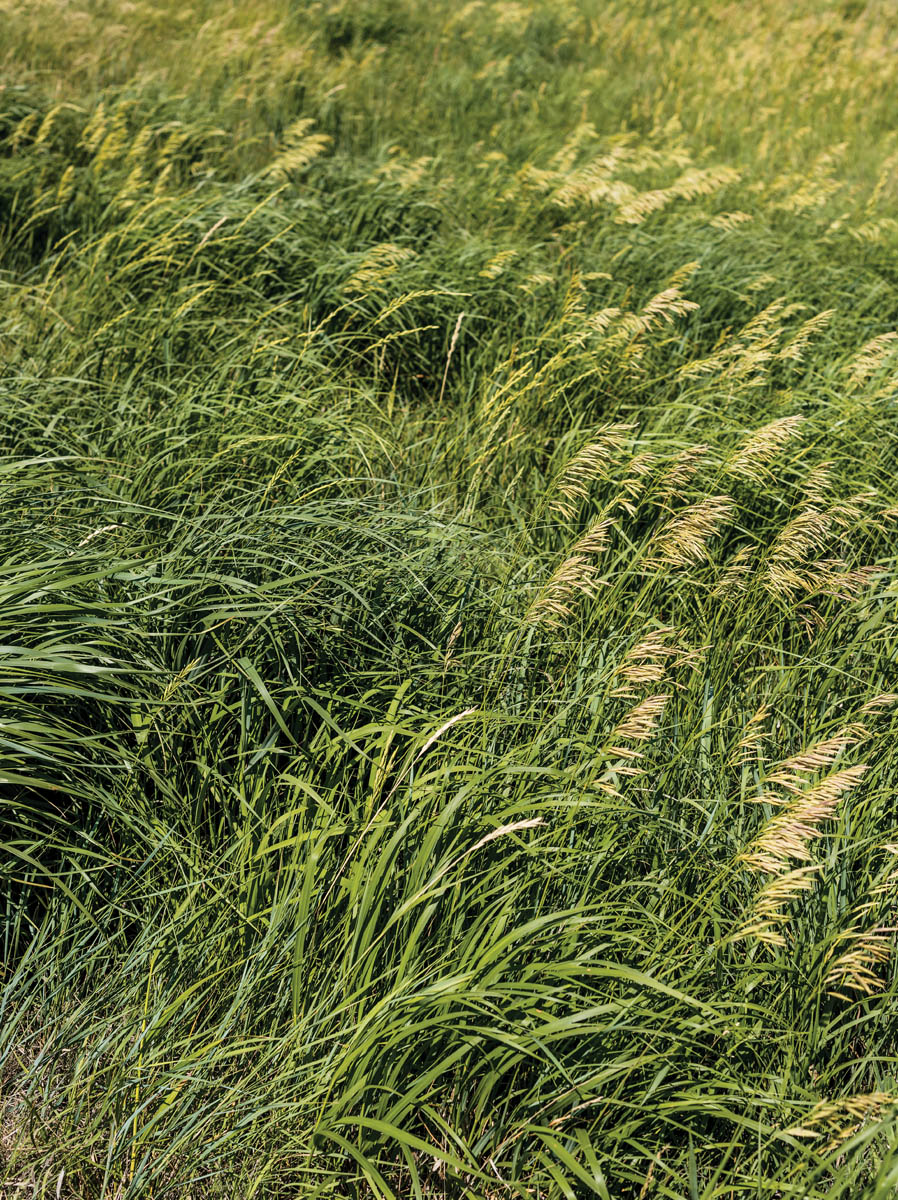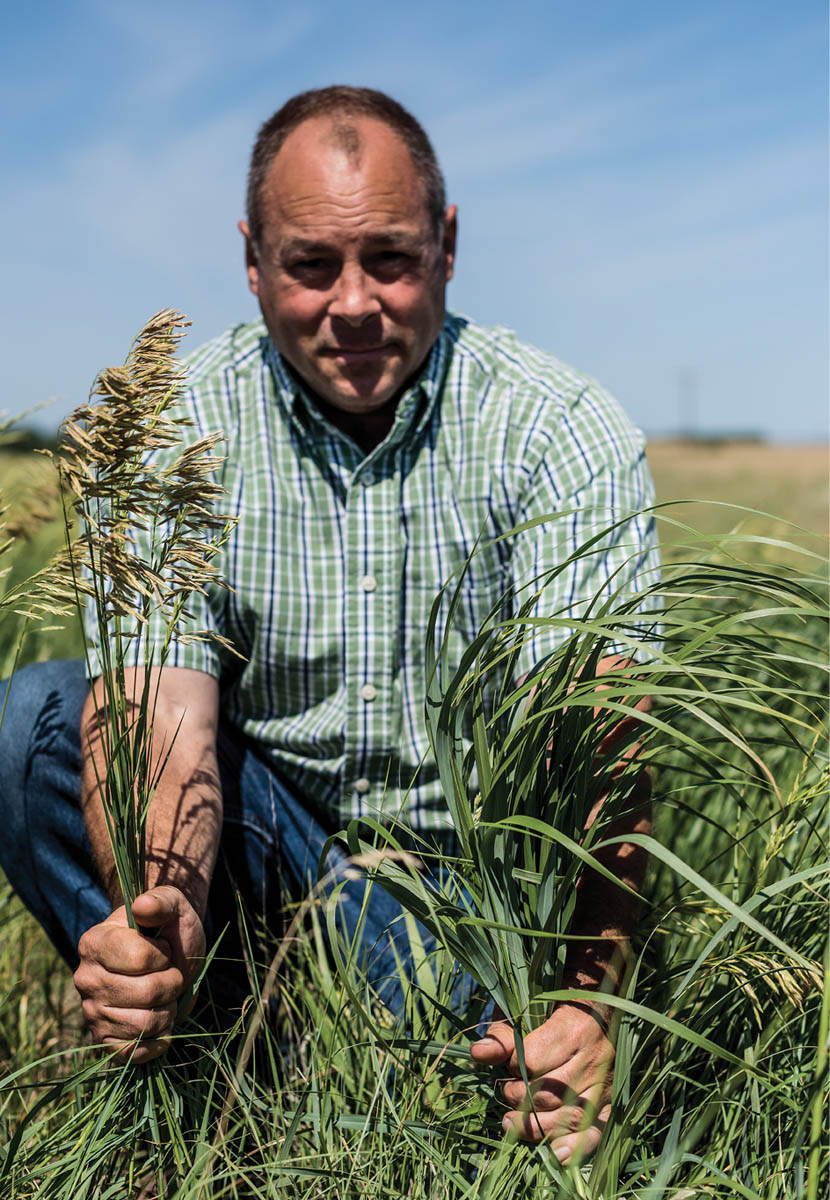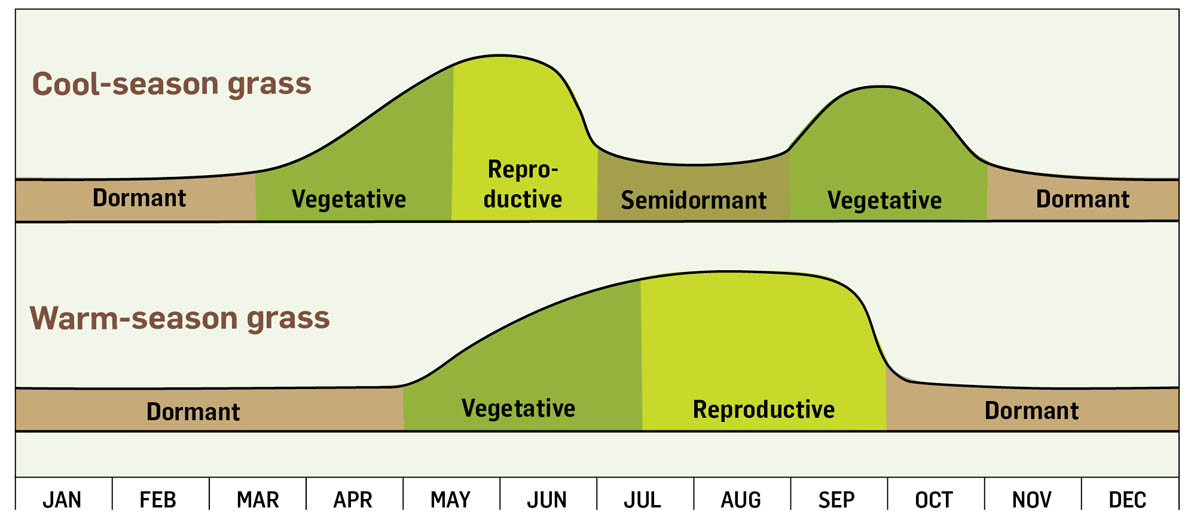

The key to operating anything better is understanding how it works. Pastures are no different. Forage plants are quite variable, and different species require different management. If we understand what makes plants grow, we can make them grow better. If we understand how they respond to grazing, we can graze them in a manner that makes them respond better. And if we understand how different plant species respond differently to various management practices, we can tailor our management to each pasture species as needed to either favor or discourage that species.
This chapter is the instruction manual for how different plants grow and their different responses to grazing timing, frequency, and intensity.
Plants use the energy from sunlight to split water (H2O) into hydrogen and oxygen. They then attach carbon dioxide (CO2) molecules to the hydrogen to form glucose, or sugar. This process is the basis of all plant growth and is the foundation of almost all higher life-forms on earth, including you and me.
Photosynthesis consists of two phases. The first is called the light reactions, during which water is split into hydrogen and oxygen. The oxygen is a waste product and exits the plant through tiny holes in the leaf surface called stomata (a single hole is a stoma).
Air enters the plant through these stomata for the second part of the photosynthetic process, called the dark reactions. An enzyme captures the CO2 from the air and attaches it to the hydrogen ions from the light reactions. Six carbon dioxide molecules join 12 hydrogen ions to form a glucose molecule.
Not all plants photosynthesize in the same manner, however. Plants use several photosynthetic pathways, and even within these there are variations according to the species that use them. For the purposes of this book, we will focus on the major recognized pathways to illustrate differences in plant management needs.
The first major pathway is called C3 because three carbon atoms form during the first stage of the process. This pathway appears in cool-season grasses and legumes, and in most woody plants.
The second major pathway is called C4, because the first stage of the process produces four carbon atoms. This pathway is found in warm-season grasses and a few broadleaf plants such as pigweeds, kochia, and saltbushes.
Another pathway is called CAM, short for crassulacean acid metabolism, named for the first product formed from CO2 during photosynthesis. CAM appears in cacti and other succulent plants such as pineapples and agave.
For the purposes of improved pasture management, we will focus on the difference between C3 and C4 plants, because slow-growing CAM plants are not used much for forage.

Cross section of a leaf that uses C3 photosynthesis

Cross section of a leaf that uses C4 photosynthesis
In C3 plants, the light reactions and dark reactions take place within the same cells. This is very convenient and works quite well until the weather gets warm and sunny. As the light reactions accelerate, the oxygen released may fail to exit the leaf fast enough. In that case, the enzyme that captures the carbon dioxide during the dark reactions can grab an oxygen molecule by mistake and pass it on through the assembly line. If that happens, at the end no glucose is formed.
This dead-end process, called photorespiration, severely limits the productivity of C3 plants when the weather is very hot and sunny and you would think plants should grow rapidly. These plants basically stall out in productivity once leaf temperatures exceed 86°F (30°C).
In C4 plants, the light reactions and dark reactions take place in separate cells within the leaf. The light reactions occur in cells just under the leaf surface, where sunlight is abundant, and close to the stomata, through which the oxygen can easily escape.
These cells also harbor a chemical that captures the carbon dioxide as it enters the stomata. The carbon dioxide and hydrogen are then pumped into a different set of cells, called the bundle sheath cells, in the interior of the leaf, and it is there that the dark reactions take place. Because the oxygen is released a good distance away from the bundle sheath cells, there is virtually no oxygen to be grabbed by the enzymes in the dark reactions, and thus there is no photorespiration.
This all makes for a very efficient method of photosynthesis in warm and sunny conditions, but due to the more complicated nature of the process, it takes warmer temperatures and more sunlight to make it work. Thus, the plants featuring this process grow only when temperatures are higher than 55°F (12.8°C) but can function well up to leaf temperatures around 100°F (37.8°C).
Grass plants have three parts to their life cycle: the vegetative phase, the reproductive phase, and the dormant phase.
The vegetative phase starts with the initiation of growth and continues until the beginning of seedhead formation. During the vegetative phase, forage quality is excellent, and the plant tolerates defoliation (haying or grazing) as long as a minimum residual stubble height is maintained.
The reproductive phase begins with the initiation of seedheads and continues until seed ripening. During the reproductive stage, forage quality declines dramatically as the fiber content of the plant increases to hold up the seedhead. Leaf production also stops, because the plant shifts all resources to filling the developing seedhead. Tolerance to severe defoliation declines dramatically during this stage.

In my right hand is a cool-season smooth bromegrass plant in reproductive stage, while the warm-season switchgrass in my left hand is vegetative.
The dormant phase is a nongrowing period for grass, almost always occurring in winter in temperate areas. During this phase, most species have very low nutritional value because most of the protein and sugars are pulled down into the root system to support next year’s growth. At this time, grasses are very tolerant of extreme defoliation; most species tolerate removal of a high percentage of topgrowth.
Note: Another phase, called a “semidormant due to photorespiration” stage, occurs in cool-season grasses in the heat of summer. Little or no growth occurs in this stage.
Growth stages occur at different times during the season for cool-season grasses and warm-season grasses, as illustrated by the chart below. This chart is applicable to my native Kansas and can be adjusted to various regions.
How Grass Changes as It Grows |
||
|---|---|---|
|
Growth Stage |
Nutritional Value to Livestock |
Tolerance of Defoliation |
|
Vegetative |
High |
Medium |
|
Reproductive |
Medium |
Low |
|
Dormant |
Low |
High |

The most studied legume is alfalfa, and that is the one discussed here. Other legumes respond differently, and some of those differences are noted below.
Like grasses, alfalfa has a vegetative, reproductive, and dormant period, but the plant responds quite differently than grasses do to defoliation. It does not regrow well if hayed or grazed in the vegetative state, but tolerance increases dramatically after it blooms.
How Alfalfa Tolerates Defoliation |
||
|---|---|---|
|
Alfalfa Growth Stage |
Nutritional Value to Livestock |
Tolerance of Defoliation |
|
Vegetative |
Very high (sometimes excessive) |
Low |
|
Reproductive |
High |
High |
|
Dormant |
Initially high, but rapidly declines |
High |
After defoliation, the energy to rebuild leaf tissue must come from carbohydrate reserves stored somewhere within the plant, or from photosynthesis within remaining leaf tissue. Grasses tend to store few carbohydrates during their active growth, and energy from regrowth must come from the remaining leaf area. That is why maintaining a minimum residual height is so critical to maximizing grass yield.
Alfalfa, on the other hand, regrows from carbohydrate reserves in the roots, and as long as the plant attains a full bloom stage (indicating it has achieved good root reserves) it can tolerate a very high percentage of defoliation.
Since plants such as alfalfa store considerable energy reserves in their roots, they can tolerate extreme levels of defoliation if root reserves are allowed to build up during sufficient rest periods. Most grasses, on the other hand, need a certain amount of residual leaf area after defoliation, or the plant will suffer and produce less.
Traditionally, this amount of allowable defoliation has been assumed to be 50 percent or less of the total seasonal growth, and if seasonal production can be estimated with a reasonable degree of accuracy, that is still a good rule of thumb. However, using intensive rotational grazing management with frequent moves, and monitoring residual stubble heights, is more effective than trying to meet a targeted percentage of plant removal over the season.
For example, if total growth is 12 inches, and the plant can tolerate a 4-inch stubble, then removal of the top 8 inches (or 67 percent) of this material is acceptable. On the other hand, if the growth is only 6 inches, removal of 50 percent, or the top 3 inches, will seriously impair regrowth because it will be grazed below the targeted 4-inch height. Managing to maintain targeted residual heights can dramatically improve plant regrowth, animal performance, and total seasonal yield.
Recommended Minimum Height of Stubble to Remain after Grazing |
|
|
Require 3-inch stubble |
Buffalograss, Kentucky bluegrass, white clover |
|
Require 4-inch stubble |
Tall fescue, orchardgrass, bird’s-foot trefoil |
|
Require 6-inch stubble |
Smooth bromegrass, big bluestem, intermediate wheatgrass |
|
Require 8-inch stubble |
Switchgrass, Indiangrass |
|
Require 12-inch stubble |
Eastern gamagrass |
Meristems are the points on the plant from which growth originates. On grasses, the meristems are in the lower part of the stem, so most are protected from grazing during the vegetative stage. Once the reproductive stage occurs, the growing points elevate aboveground and become susceptible to removal during defoliation. Elimination of a growing point will force the plant to begin growth from a lower growing point. This will almost always reduce total forage yield but can sometimes be desirable as a means to stimulate more vegetative growth.
The uppermost growing point in a grass tiller, called the apical meristem, is just below the seedhead. Apical dominance is the production of hormones by the apical meristem; this suppresses growth of lower meristems and channels plant resources toward the developing seedhead.
Although desirable for seed production, this greatly harms forage quality, since leaf production stops. Removal of the apical meristem by mowing at a very high stubble height (clipping just the seedhead off but leaving the lower leaves intact) can trigger production of new, high-quality leaves from meristems lower on the plant.

In the vegetative stage, grass meristems are very close to the soil level and inaccessible to grazing animals. In the reproductive stage, meristems are elevated aboveground and vulnerable to removal.
